Ageing and sexing details:
|
JAN - JUL: after-hatch-year
unknown (probably after-second-year) |
Body plumage provides relatively little
information about age and sex. On average, males have a more extensively
rusty crown, but there is considerable overlap and sex should be
determined only by brood patch or cloacal protuberance. In winter,
SY birds have less rufous in the crown than ASY birds, but by
March/April the prealternate molt has largely eliminated this
difference. Since some HY birds undergo a complete preformative molt, individuals which in spring show typical ASY traits should more conservatively be aged as AHY.

A typical AHY (ASY) Swamp Sparrow, showing extensive rufous on the wing.
Photo by Marcel Gahbauer,
McGill Bird Observatory (QC), May 2010
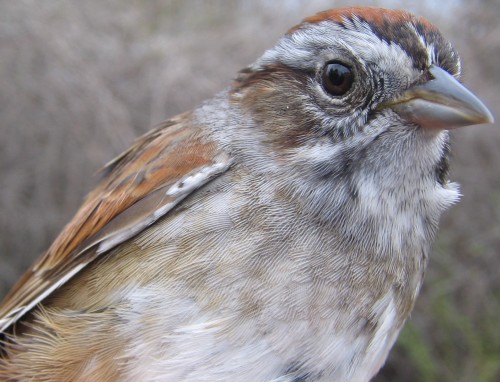
A front view of a Swamp Sparrow with a relatively extensive rusty cap, likely a male.
Photo by Marie-Anne Hudson,
McGill Bird Observatory (QC), April 2006
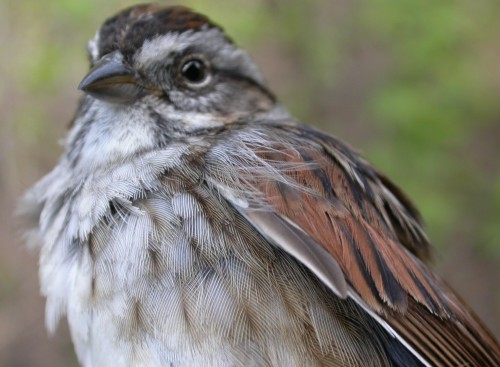
A front view of a Swamp Sparrow with a relatively limited rusty cap, likely a female.
Photo by Marcel Gahbauer,
McGill Bird Observatory (QC), May 2006
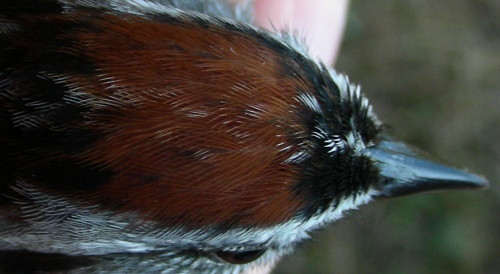
The crown of an AHY (probable ASY) Swamp Sparrow, likely a male by the extent of the cap.
Photo by Marie-Anne Hudson,
McGill Bird Observatory (QC), April 2009
AHY (ASY) birds typically have distinct rusty edges to their primary coverts, primaries, and secondaries, without a distinct molt limit on the wing.
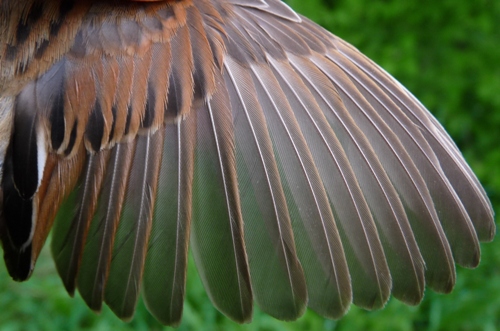
A typical AHY (ASY) wing, showing a pseudolimit between the greater coverts and the rest
of the wing, and rusty edging to most feathers.
Photo by Marcel Gahbauer,
McGill Bird Observatory (QC), May 2010
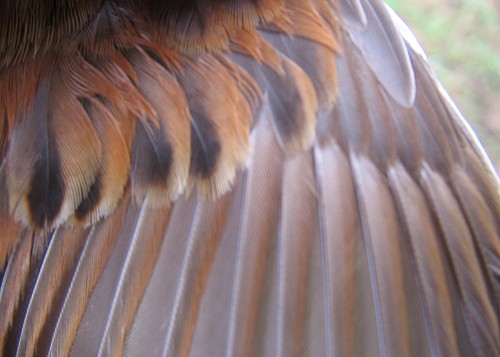
A closeup showing distinct rusty edging to the primary coverts.
Photo by Marie-Anne Hudson,
McGill Bird Observatory (QC), April 2006
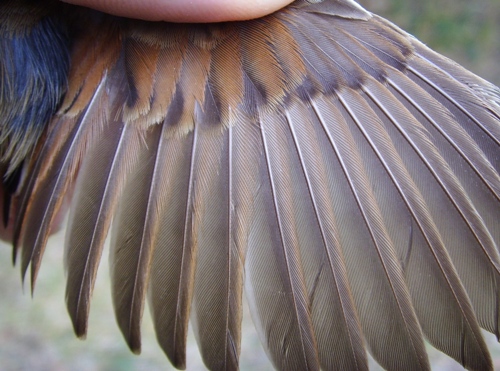
Although there appears to be more of a contrast in this case between the greater coverts and
rest of the wing, there is still distinct rusty edging to the dark and broad primary coverts.
Photo by Peter Pyle, Merry Lea (IN), May 2007
A typical AHY (ASY) tail is relatively broad, though by spring may be quite
abraded, especially at the tips. Beware, however, that Swamp
Sparrows occasionally replace their rectrices prematurely, and therefore
an adult tail is not in itself sufficient to conclude a bird is ASY.
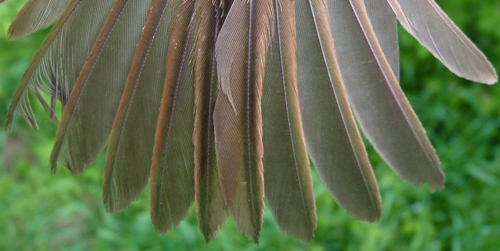
A typical ASY tail, with relatively broad and rounded feathers, and the central rectrices
showing somewhat greater wear than the others.
Photo by Marcel Gahbauer,
McGill Bird Observatory (QC), May 2010

The tail of a known ASY Swamp Sparrow, somewhat more frayed than the previous
example, but still showing the broad and rounded rectrices as expected.
Photo by Marie-Anne Hudson,
McGill Bird Observatory (QC), April 2009
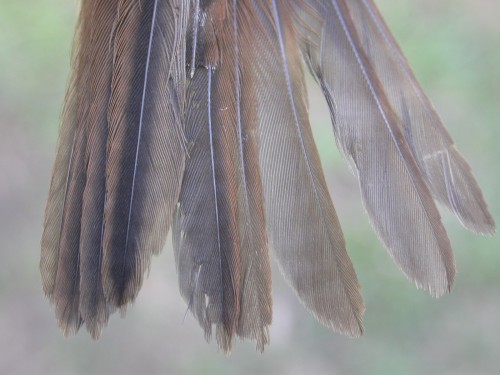
Another known ASY Swamp Sparrow with a particularly worn tail that could be mistaken for
a SY pattern, illustrating the importance of also considering molt limits on the wing for ageing.
Photo by Marcel Gahbauer,
McGill Bird Observatory (QC), May 2006
RETURN TO AGE/SEX
OVERVIEW
|
JAN - JUL: second-year
unknown |
Body plumage provides relatively little
information about age and sex. As in AHY (ASY) Swamp Sparrows, males on average have a more extensive rusty crown, but there is overlap by sex, and early in the season the prealternate molt may not yet be complete.
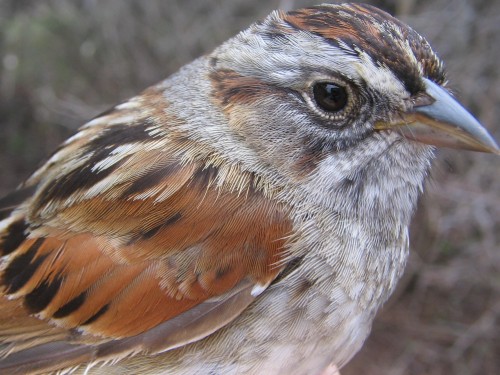
A typical SY Swamp Sparrow, showing some contrast on the wing (though a view of the open
wing would be required to confirm the molt limit). In this case there is little rust on the crown,
which may suggest this is a female, but given the early spring date, could also be a male
that has not completed its prealternate molt.
Photo by Marie-Anne Hudson,
McGill Bird Observatory (QC), April 2006
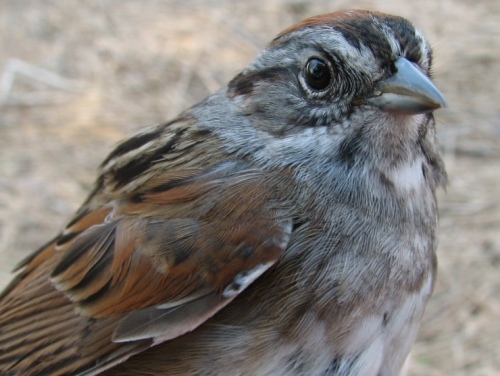
Another example, with the molt limit on the wing indistinct from this angle.
Photo by Barbara Frei, McGill Bird Observatory (QC), April 2008
SY
birds show a molt limit between the dark formative greater coverts and the paler block of retained juvenile primary coverts, primaries, and secondaries.

A typical SY wing, showing the typical molt limit, with limited rusty edging on the flight feathers.
Photo by Gay Gruner,
McGill Bird Observatory (QC), June 2009
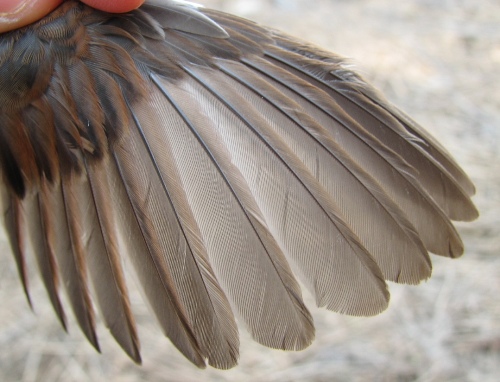
Another example, illustrating that the outer primary coverts are quite narrow and pointed.
Photo by Barbara Frei,
McGill Bird Observatory (QC), April 2008
Swamp Sparrows of all ages usually have quite abraded tails by spring,
but those of SY birds tend to be particularly tattered, and usually
narrower along the shaft of each feather, but there is a fair amount of variation and some overlap exists between lightly worn SY tails and heavily worn ASY tails.
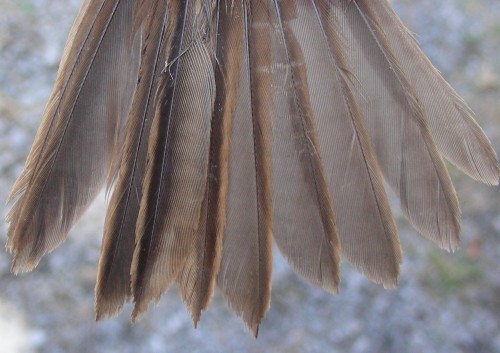
A moderately good condition SY tail, showing wear at the tips, and a more pointed
shape to the rectrices
than is typical for ASY tails.
Photo by Marie-Anne Hudson, McGill Bird Observatory (QC), April 2008

A more worn tail, illustrating the contrast between the retained juvenile rectrices and the
two outermost feathers on the right side that have been prematurely replaced.
Photo by Gay Gruner,
McGill Bird Observatory (QC), June 2009
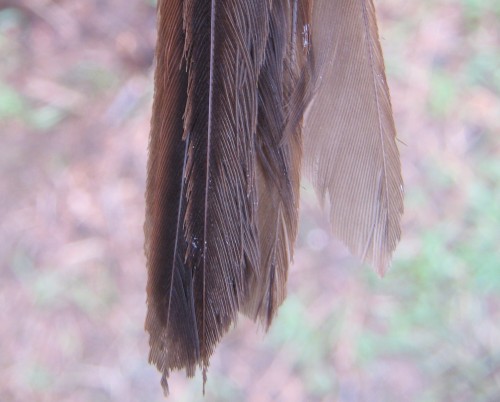
An example of an extremely worn SY tail.
Photo by Marie-Anne Hudson,
McGill Bird Observatory (QC), April 2006
RETURN TO AGE/SEX
OVERVIEW
|
JUN - DEC: after-hatch-year
unknown |
AHY birds typically have a noticeable amount of rust on the crown, back, and wings compared to HY birds. AHY birds with an extensively rusty crown are more likely to be males, but sex can generally be determined only in the hand, as long as breeding characteristics (brood patch or cloacal protuberance) remain evident.
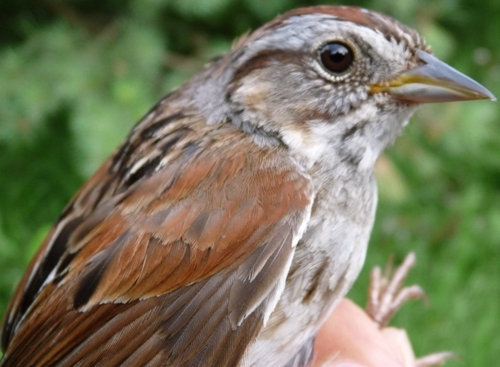
A typical AHY Swamp Sparrow, with a partly rusty cap and extensive rust on the wing.
Photo by Marcel Gahbauer,
McGill Bird Observatory (QC), August 2009
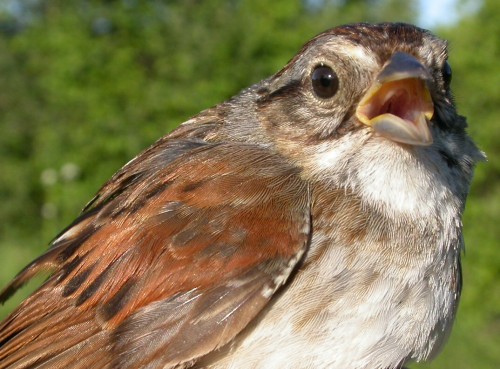
Another AHY Swamp Sparrow, with the sun highlighting the rusty tone of the wing.
Photo by Marcel Gahbauer,
McGill Bird Observatory (QC), August 2005
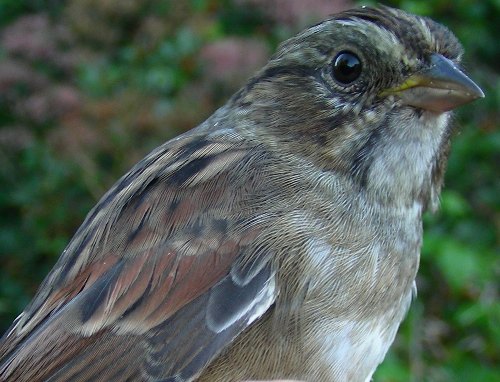
A much paler example, with no rust on the crown and a more olive tone to the head. Although
considered to be AHY at the time of banding in 2008, due in part to the observation of active
molt among the secondaries (see wing photo below), the discovery that some HY birds
undergo a complete preformative molt suggests this may be a HY bird that has done so.
Photo by Marcel Gahbauer, McGill Bird Observatory (QC), September 2008
AHY Swamp Sparrows usually have rusty edging to the feathers on the wing, without a distinct molt limit.

An AHY wing showing the expected colour pattern, although the primary coverts appear
relatively narrow and pointed.
Photo by Marcel Gahbauer,
McGill Bird Observatory (QC), August 2009
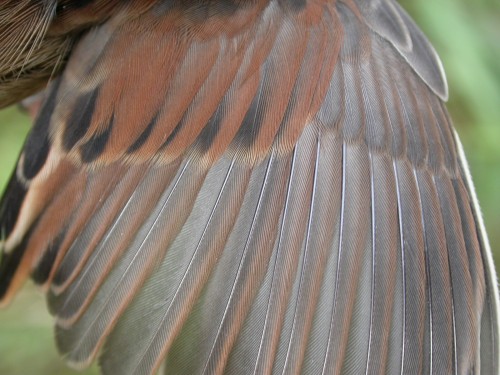
A closeup showing the more typical broad and rounded shape to the primary coverts.
Photo by Marcel Gahbauer,
McGill Bird Observatory (QC), August 2005
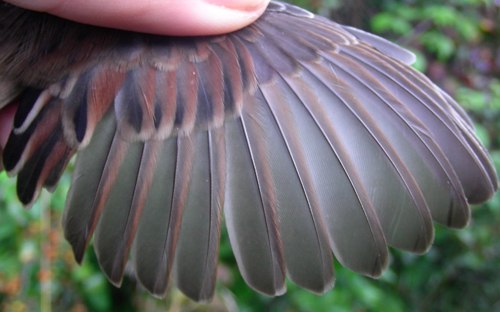
A wing in active molt, corresponding to the last bird in the section above. Although Pyle (1997)
indicates that the preformative molt is limited to the median and greater coverts, and sometimes
the tertials and central rectrices, examples in the HY section below illustrate that at least some
HY birds are replacing their primary coverts, primaries and secondaries. The photo above
illustrates an individual nearing the completion of its molt, but it may not be possible to
determine age from this evidence (at this date skull ossification would still be reliable).
Photo by Marcel Gahbauer, McGill Bird Observatory (QC), September 2008
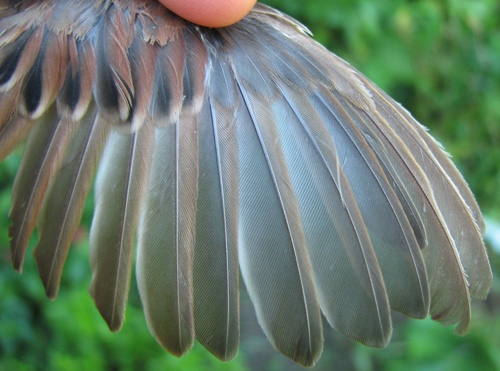
A wing in active molt earlier in the season, showing a significant enough contrast between
the fresh feathers and the wear on the old feathers to be confident that this is an AHY bird.
Photo by Barbara Frei, McGill Bird Observatory (QC), August 2008
Rectrices of AHY Swamp
Sparrows are broader and more rounded than those of HY birds, but tails
can become quickly abraded at any age, and are best used as a complement
to other ageing criteria than as a primary indicator of age.
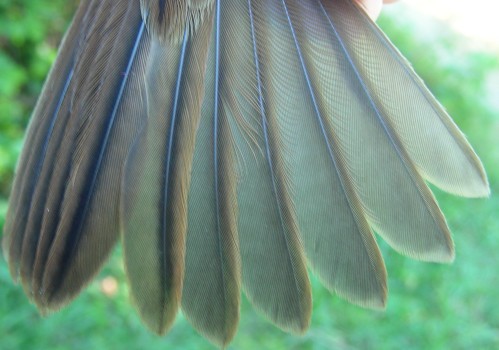
A typical AHY tail, with broad rectrices that are somewhat rounded toward the tip.
Photo by Marie-Anne
Hudson, McGill Bird Observatory (QC), September 2007
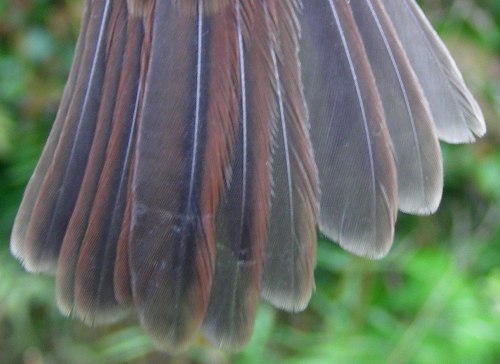
An example with even more rounded rectrices, but already showing some wear by September.
Photo by Marcel Gahbauer,
McGill Bird Observatory (QC), September 2008
RETURN TO AGE/SEX
OVERVIEW
|
JUN - AUG: second-year
unknown |
In mid-late summer, it is occasionally
possible to age some Swamp Sparrows as SY. As all AHY birds will
be molting extensively at this time, the key is to look for retained
juvenile feathers, which are very pale and contrast sharply with
adjacent replaced feathers.
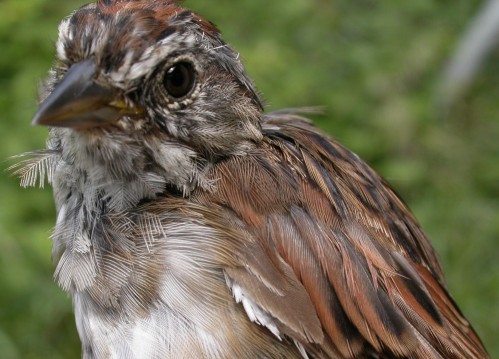
The particularly faded and worn greater alula visible from this angle is likely a retained
juvenile feather, but the open wing needs to be seen to provide better evidence.
Photo by Marcel Gahbauer,
McGill Bird Observatory (QC), August 2005
The photo below illustrates a wing in mid-moult, with
one secondary just growing in, and all the inner ones still unreplaced.
Note the very old outer primary covert, as well as the unreplaced outer
two primaries.
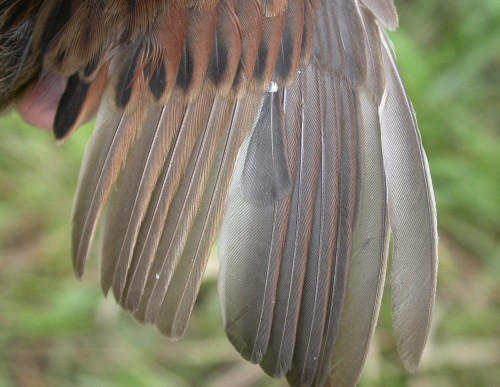
Photo by Marcel Gahbauer,
McGill Bird Observatory (QC), August 2005
The tail is not helpful
in diagnosing individuals as SY. In this photo, all feathers are
already replaced; a bird caught in an earlier stage of molt would still
retain some old juvenile rectrices, but beware that by this time of year all tail feathers are likely to be quite worn regardless of age, so may be of limited value for ageing except in extreme cases.
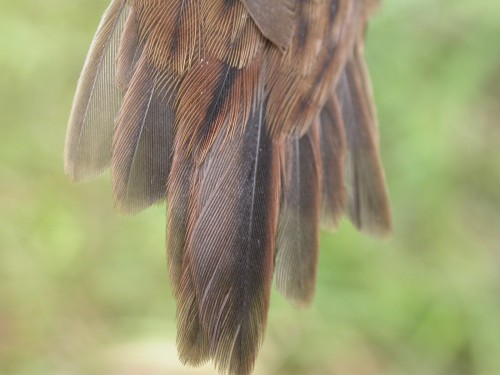
Photo by Marcel Gahbauer,
McGill Bird Observatory (QC), August 2005
RETURN TO AGE/SEX
OVERVIEW
|
JUN - DEC: hatch-year
unknown |
Swamp Sparrows with no or very little rust
on the crown are more likely to be HY birds, but this should always be
confirmed by looking at the wing and tail. There is also often a more olive-brown tone ot the head plumage than in AHY birds. Sex cannot be
determined for HY birds.
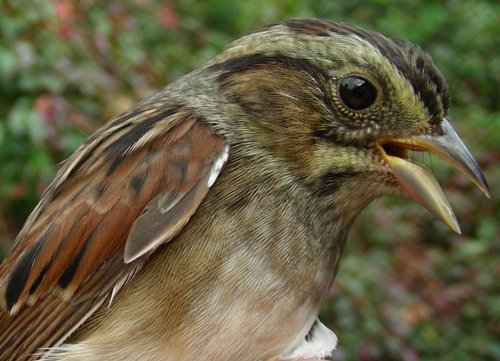
A typical HY Swamp Sparrow.
Photo by Marcel Gahbauer, McGill Bird Observatory (QC), September 2008
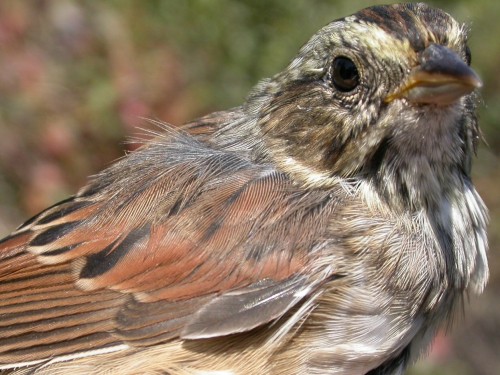
A HY Swamp Sparrow still retaining some juvenile breast streaking.
Photos by Marcel Gahbauer,
McGill Bird Observatory (QC), September 2005
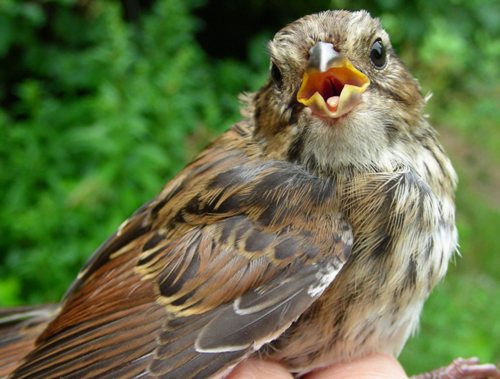
A younger Swamp Sparrow still with extensive breast streaking.
Photo by Marie-Anne
Hudson, McGill Bird Observatory (QC), August 2008
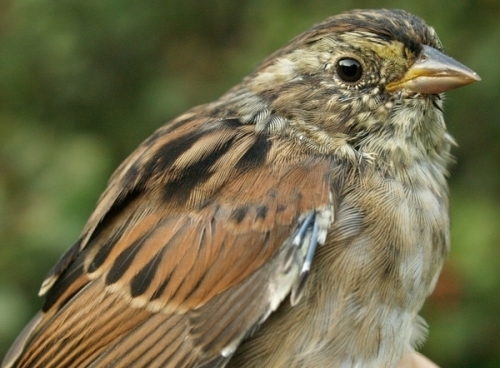
A HY Swamp Sparrow still with some light streaking on the breast, but replacing its outer
primary coverts and primaries in an unusually extensive preformative molt.
Photo by Simon Duval,
McGill Bird Observatory (QC), September 2010
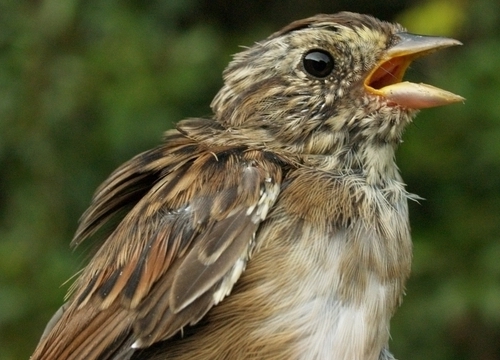
Another HY Swamp Sparrow undergoing an unusually extensive preformative molt.
Photo by Simon Duval,
McGill Bird Observatory (QC), August 2010
HY Swamp Sparrows typically have dull wings, with a molt limit between the darker and rusty-edged formative greater coverts and the paler block of primary coverts, primaries, and secondaries, with only indistinct rusty edging. However, while Pyle (1997) describes the preformative molt as being limited to the median and greater coverts, and sometimes the tertials and central rectrices, several locally-hatched juveniles at McGill Bird Observatory have been documented replacing their flight feathers and tails during their preformative molt, suggesting that in some individuals it may be complete.
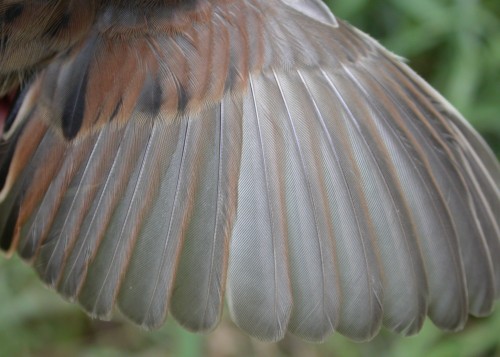
A typical HY wing, in which the greater coverts and tertials have been replaced, contrasting
with the paler unreplaced juvenile feathers on the rest of the wing.
Photo by Marcel Gahbauer,
McGill Bird Observatory (QC), September 2005
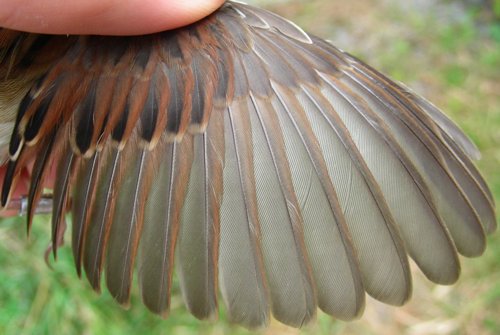
Another example of the typical pattern, although this individual has somewhat more
distinct rusty edging on the primary coverts and secondaries in particular.
Photo by Marie-Anne
Hudson, McGill Bird Observatory (QC), September 2008

A HY Swamp Sparrow replacing its outermost primary and primary coverts.
Photo by Simon Duval,
McGill Bird Observatory (QC), September 2010
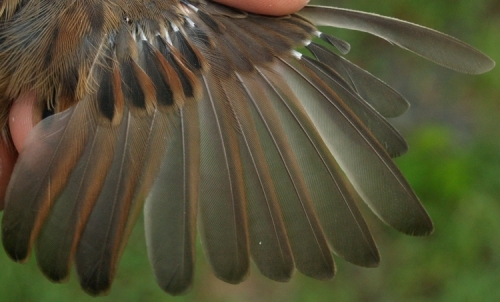
A more extensive molt underway, with the primaries being replaced from the outside inward,
at the same time that the greater coverts are being replaced.
Photo by Simon Duval,
McGill Bird Observatory (QC), August 2010

Another example of unusually extensive preformative molt, with primaries being
replaced at the same time as the greater coverts.
Photo by Simon Duval,
McGill Bird Observatory (QC), August 2010
HY Swamp Sparrows typically have somewhat narow and tapered rectrices, though sometimes the central pair have been replaced and are contrastingly fresh and dark.
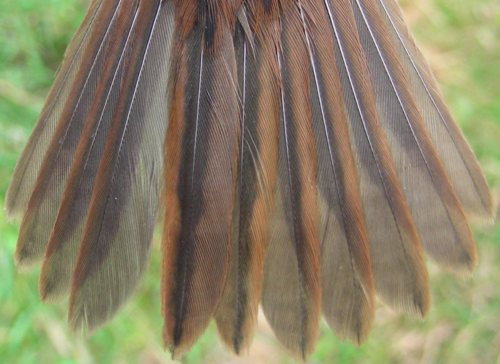
A relatively fresh HY tail in good condition, but with rectrices somewhat narrower on
average than typical of AHY Swamp Sparrows.
Photo by Marcel Gahbauer, McGill Bird Observatory (QC), September 2008
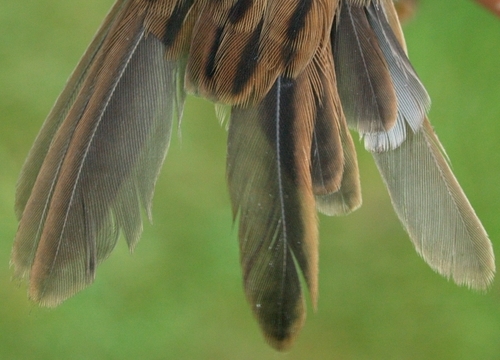
Unusually extensive preformative molt, with multiple rectrices being replaced.
Photo by Simon Duval,
McGill Bird Observatory (QC), September 2010
RETURN TO AGE/SEX
OVERVIEW
|
JUN - SEP: juvenile unknown |
Juvenile Swamp Sparrows largely lack the
rusty colouration that is otherwise typical of the species. They
can be recognized by the fine spotting on the upper breast, dark greater
coverts with rusty edges, and (if fully grown), shorter wing than Song
Sparrow and many other similar species.
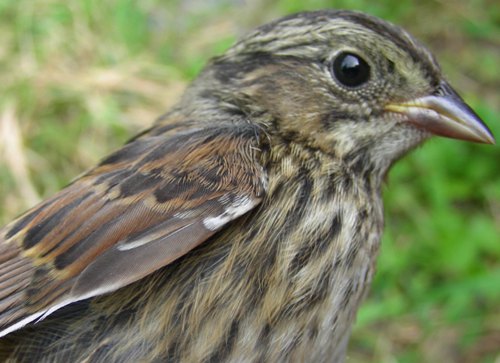
A typical juvenile, strongly streaked below, distinguishable from Song Sparrow by the
dark-centered greater coverts, more olive facial complexion, and proportionately long bill.
Photo by Marcel Gahbauer, McGill Bird Observatory (QC), August 2008
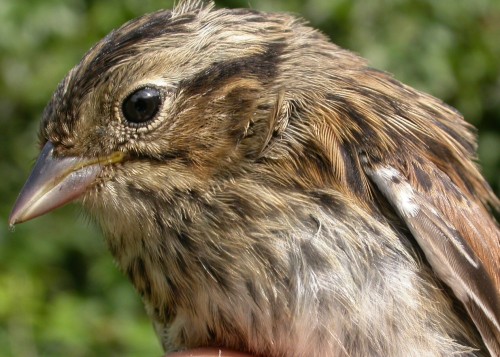
Another juvenile, illustrating the extensive but relatively fine streaking on the breast.
Photo by Marcel Gahbauer,
McGill Bird Observatory (QC), July 2005
A fresh juvenile wing shows the dark greater coverts with rusty and buff
edging that are characteristic of Swamp Sparrows; ageing is more easily
accomplished by looking at the body overall.

A typical juvenile wing, relatively uniformly dull and dark.
Photo by Marie-Anne
Hudson, McGill Bird Observatory (QC), September 2007
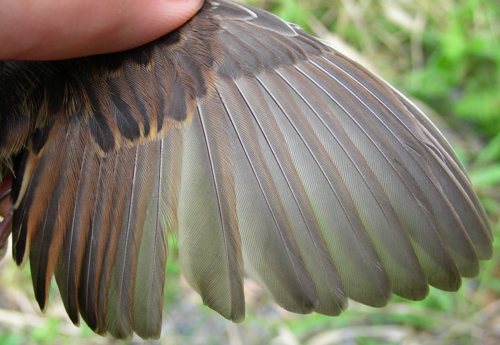
Another typical juvenile wing.
Photo by Marcel Gahbauer, McGill Bird Observatory (QC), August 2008
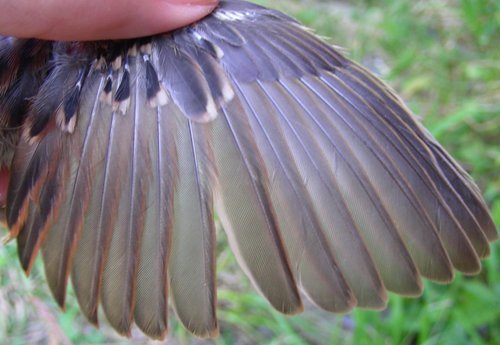
The same individual as above, one week later, beginning to replace its greater coverts.
Photo by Marcel Gahbauer, McGill Bird Observatory (QC), August 2008
Juvenile rectrices are relatively narrow and tapered, but typically in good condition since they are fresh.
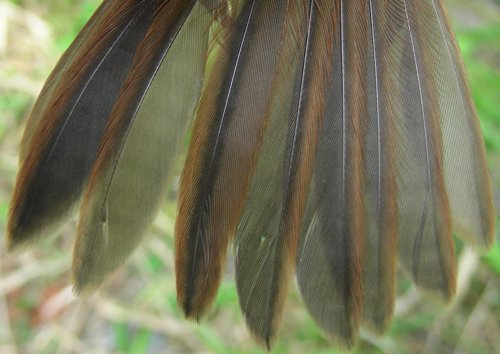
Photo by Marcel Gahbauer, McGill Bird Observatory (QC), August 2008
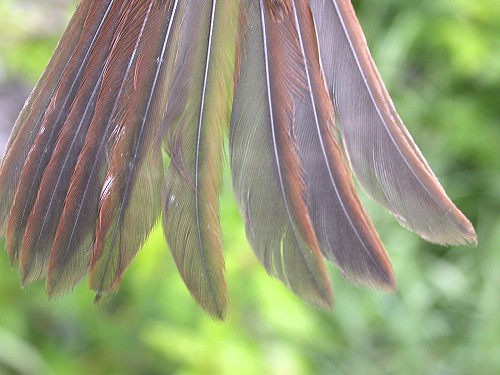
Photo by Marcel Gahbauer,
McGill Bird Observatory (QC), July 2005
RETURN TO AGE/SEX
OVERVIEW


































































